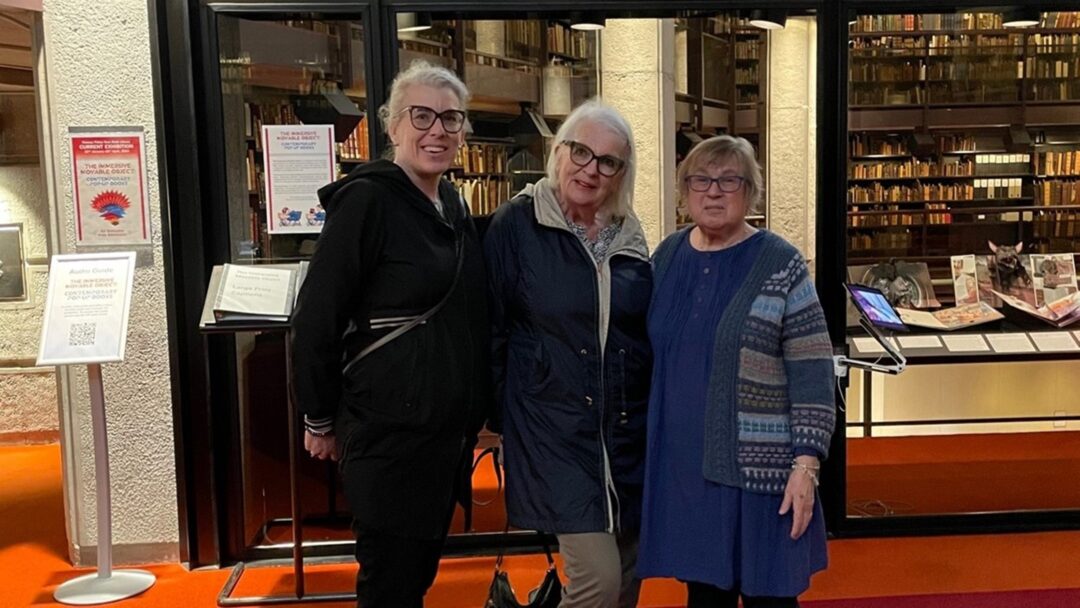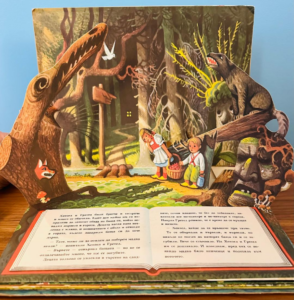Beyond the fold: Reflections on my grandfather’s artistic legacy and looking forward as the director of the Integrated Rehabilitation & Humanities program

Photo left to right: Brenda Vrkljan, Dagmar Kubaštova-Vrkljan, & Joan Links (Exhibit Curator)
By: Brenda Vrkljan
My mom and I recently travelled to the University of Toronto’s Thomas Fisher Rare Book Library where the illustrations of my grandfather Vojtěch Kubašta, were on display alongside some of the earliest iterations of moveable books in their collection.
Joan Links, a retired librarian and curator of this exhibition, met us at the entrance and kindly guided us between the various displays that were thematically organized. In the first display, the different approaches to moveable books were introduced, including my grandfather’s ‘pop-up’ technique, as illustrated in his depiction of Hansel and Gretl (Prague Artia, 1959). While the books in the exhibit are protected by glass from prying hands, I recalled the joy of playing with these pop-ups as a child.

Walking through the exhibit, I reflected on our new undergraduate program, the Bachelor of Health Sciences (Honours) Integrated Rehabilitation and Humanities (IRH) program. I jotted down some of these reflections, which I share below.
Creating your narrative
Stories can invite us into a shared context. The added ‘pop-up’ effect of the books within the Fisher Library’s current exhibit is a reminder of the creativity that is possible even within a well-told story, like Hansel and Gretl. If I draw an analogy to the IRH program, the learning opportunities that have been designed across Levels II-IV build on the respective strengths of both the Humanities and Health Sciences at McMaster.
These strengths and corresponding structures of these unique and highly complementary MacMaster faculties provide the necessary foundation for learning in the IRH program. The ‘pop-up’ effect of these books reflects the creativity that students and faculty bring to each learning experience, as reflected in the coursework within this unique program.
Practice makes perfect, but perfect means practice
As outlined in the introduction of the exhibit’s catalogue, ‘Immersive Moveable Object: Contemporary pop-up books’, paper defies our preconceptions: “Our preconception of paper is that it is flat, weak, and easily damaged. Books or codices are flat rectangles that open to flat paper pages that should be carefully handled…” (p. 1). How then did my grandfather come to realize that you could engineer paper to create marvellous and magical worlds? Not surprisingly, through his degree (architecture, civil engineering) and, yes, practice.
My mom recalls how he trialled his ‘paper’ mock-ups over and over again until they were perfect. As you can see on the page from Hansel and Gretl, the folds at the spine of the book transform into a table or a treasure chest of gold. The notion of practice is a reminder that we develop expertise in our disciplines by studying and learning from others. Within the exhibit, one can see how contemporary paper engineers are using techniques first developed by my grandfather.
Within the IRH program, students will not only learn from theorists and theories, past and present, but also explore how these theories might apply (or not) to different clinical situations and other circumstances.
Enjoyment
During one of his trips to Canada in the early 1980s, my grandfather visited my grade 2 class in Peterborough, Ontario. We all sat on the carpet and marvelled, as he turned the pages. Inspired, we went to our desks to create our own ‘pop-up’ worlds. Some of these crayon masterpieces surely ended up on the fridge at the homes of my classmates that evening. While my grandfather loved what he did, there is no doubt there were times when his mock-ups fell flat. Within the IRH program, there may be times when a learning activity does not go exactly as planned. During such times, one must remember that enjoyment comes from the process, not the product.
Taking in the exhibit provided an opportunity to pause and reflect, but also to look forward. Understanding the complexities of health and wellness is strengthened by bridging the creativity from the humanities with rehabilitation science. This bridge helped me view this exhibit differently. Visiting the Fisher library was a reminder of the importance of the arts and creativity as well as innovations that come from learning from one another – all key tenets of McMaster’s newest undergraduate degree, the Bachelor of Health Science – IRH program.
I’m excited to be leading this unique undergraduate program where the arts and science come together to support health and well-being that builds on a legacy of creativity, innovation, and academic excellence for which the Faculties of Humanities and Health Sciences are known.
Learn more about the Bachelor of Health Sciences (BHSc), Integrated and Rehabilitation (IRH) Undergraduate degree – click here
Have questions? Email us anytime: irhbhsc@mcmaster.ca
IRH General News